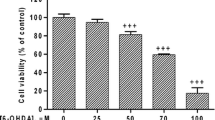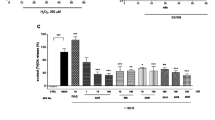Abstract
Following initial diagnosis of Parkinson’s disease, if it were possible to prescribe a treatment that could halt or prevent further neurodegeneration, disease progression could be prevented. The aim of this study was to generate a quick and reliable assay for assessing putative neuroprotective agents for parkinsonian patients. Abnormalities in mitochondria, proteasome and lysosome function, as well as oxidative stress cause cell death in Parkinson’s disease. Thus, we exposed neuroblastoma (SH-SY5Y) cells to EC50 of toxins that mimic these cell death mechanisms (dopamine to induce oxidative stress; naphthazarin to inhibit lysosome function; proteasome inhibitor N-carbobenzyloxy-Ile-Glu(O-t-butyl)-Ala-leucinal (PSI) to inhibit the UPS (ubiquitin proteasome system) and rotenone to inhibit mitochondria function) in the presence of five compounds previously chosen as neuroprotective agents, and assessed cell viability. Coenzyme Q10 (117 μM) significantly protected against four toxins, dopamine: 16.3 ± 3.3%; naphthazarin: 10.8 ± 1.1%; PSI: 16.2 ± 2.9%; rotenone: 53.2 ± 4.2%; whereas caffeine (140 μM), creatine (25 mM), nicotine (1 μM) and deprenyl (10 μM) provided protection against some, but not all toxins. Interestingly, coenzyme Q10 is the only compound out of the five that showed neuroprotective potential in clinical trials. Thus, there is a direct correlation between the success of disease modifying agents in the clinic and their ability to protect against multiple cell death mechanisms in this assay. We propose that exposure of SH-SY5Y cells to different toxins that recapitulate cell death mechanisms in Parkinson’s disease serves as a rapid and reliable method to test neuroprotective agents that may succeed in clinical trials.



Similar content being viewed by others
Abbreviations
- ATP:
-
Adenosine-5′-triphosphate
- MOAB :
-
Monoamine oxidase B
- CINAPS:
-
Committee to identify neuroprotective agents in Parkinson’s.
- DMSO:
-
Dimethyl sulfoxide
- l-DOPA:
-
l-3,4-Dihydroxyphenylalanine
- NINDS:
-
National Institute of Neurologic Disorders and Stroke
- MPTP:
-
1-Methyl-4-phenyl-1,2,3,6-tetrahydropyridine
- NAP:
-
5,8-Dihydroxy-1,4-naphthoquinone
- PSI:
-
N-arbobenzyloxy-Ile-Glu(O-t-butyl)-Ala-leucinal
- ROT:
-
Rotenone
- SH-SY5Y:
-
Catecholaminergic neuroblastoma cells
- UPS:
-
Ubiquitin proteasome system
References
Andres RH, Huber AW, Schlattner U, Perez-Bouza A, Krebs SH, Seiler RW, Wallimann T, Widmer HR (2005) Effects of creatine treatment on the survival of dopaminergic neurons in cultured fetal ventral mesencephalic tissue. Neuroscience 133:701–713
Ardley HC, Scott GB, Rose SA, Tan NG, Robinson PA (2004) UCH-L1 aggresome formation in response to proteasome impairment indicates a role in inclusion formation in Parkinson’s disease. J Neurochem 90:379–391
Bender A, Koch W, Elstner M, Schombacher Y, Bender J, Moeschl M, Gekeler F, Muller-Myhsok B, Gasser T, Tatsch K, Klopstock T (2006) Creatine supplementation in Parkinson disease: a placebo-controlled randomized pilot trial. Neurology 67:1262–1264
Betarbet R, Sherer TB, Greenamyre JT (2005) Ubiquitin-proteasome system and Parkinson’s diseases. Exp Neurol 191(Suppl 1):S17–S27
Canu N, Barbato C, Ciotti MT, Serafino A, Dus L, Calissano P (2000) Proteasome involvement and accumulation of ubiquitinated proteins in cerebellar granule neurons undergoing apoptosis. J Neurosci 20:589–599
Ciechanover A (2005) Proteolysis: from the lysosome to ubiquitin and the proteasome. Nat Rev Mol Cell Biol 6:79–87
Cleren C, Yang L, Lorenzo B, Calingasan NY, Schomer A, Sireci A, Wille EJ, Beal MF (2008) Therapeutic effects of coenzyme Q10 (CoQ10) and reduced CoQ10 in the MPTP model of Parkinsonism. J Neurochem 104:1613–1621
Dagda RK, Zhu J, Kulich SM, Chu CT (2008) Mitochondrially localized ERK2 regulates mitophagy and autophagic cell stress: implications for Parkinson’s disease. Autophagy 4:770–782
Di Fonzo A et al (2007) ATP13A2 missense mutations in juvenile parkinsonism and young onset Parkinson disease. Neurology 68:1557–1562
Ernster L, Dallner G (1995) Biochemical, physiological and medical aspects of ubiquinone function. Biochim Biophys Acta 1271:195–204
Ferger B, Teismann P, Earl CD, Kuschinsky K, Oertel WH (1999) Salicylate protects against MPTP-induced impairments in dopaminergic neurotransmission at the striatal and nigral level in mice. Naunyn Schmiedebergs Arch Pharmacol 360:256–261
Forsmark-Andree P, Lee CP, Dallner G, Ernster L (1997) Lipid peroxidation and changes in the ubiquinone content and the respiratory chain enzymes of submitochondrial particles. Free Radic Biol Med 22:391–400
Hanrott K, Gudmunsen L, O’Neill MJ, Wonnacott S (2006) 6-Hydroxydopamine-induced apoptosis is mediated via extracellular auto-oxidation and caspase 3-dependent activation of protein kinase Cdelta. J Biol Chem 281:5373–5382
Hara MR, Thomas B, Cascio MB, Bae BI, Hester LD, Dawson VL, Dawson TM, Sawa A, Snyder SH (2006) Neuroprotection by pharmacologic blockade of the GAPDH death cascade. Proc Natl Acad Sci USA 103:3887–3889
Heemskerk J, Tobin AJ, Ravina B (2002) From chemical to drug: neurodegeneration drug screening and the ethics of clinical trials. Nat Neurosci 5 Suppl:1027–1029
Hoglinger GU, Carrard G, Michel PP, Medja F, Lombes A, Ruberg M, Friguet B, Hirsch EC (2003) Dysfunction of mitochondrial complex I and the proteasome: interactions between two biochemical deficits in a cellular model of Parkinson’s disease. J Neurochem 86:1297–1307
Hornykiewicz O (1966) Dopamine (3-hydroxytyramine) and brain function. Pharmacol Rev 18:925–964
Jenner P (2003) Oxidative stress in Parkinson’s disease. Ann Neurol 3:S26–S38
Kataoka M, Tonooka K, Ando T, Imai K, Aimoto T (1997) Hydroxyl radical scavenging activity of nonsteroidal anti-inflammatory drugs. Free Radic Res 27:419–427
Kiffin R, Christian C, Knecht E, Cuervo AM (2004) Activation of chaperone-mediated autophagy during oxidative stress. Mol Biol Cell 15:4829–4840
Kitada T, Asakawa S, Hattori N, Matsumine H, Yamamura Y, Minoshima S, Yokochi M, Mizuno Y, Shimizu N (1998) Mutations in the parkin gene cause autosomal recessive juvenile Parkinsonism. Nature 392:605–608
Kragten E, Lalande I, Zimmermann K, Roggo S, Schindler P, Muller D, van Oostrum J, Waldmeier P, Furst P (1998) Glyceraldehyde-3-phosphate dehydrogenase, the putative target of the antiapoptotic compounds CGP 3466 and R-(−)-deprenyl. J Biol Chem 273:5821–5828
Lai CT, Yu PH (1997) R(−)-deprenyl potentiates dopamine-induced cytotoxicity toward catecholaminergic neuroblastoma SH-SY5Y cells. Toxicol Appl Pharmacol 142:186–191
Matthews RT, Yang L, Browne S, Baik M, Beal M (1998) Coenzyme Q10 administration increases brain mitochondrial concentration and exerts neuroprotective effects. Proc Natl Acad Sci USA 95:8892–8897
Menke T, Gille G, Reber F, Janetzky B, Andler W, Funk RH, Reichmann H (2003) Coenzyme Q10 reduces the toxicity of rotenone in neuronal cultures by preserving the mitochondrial membrane potential. Biofactors 18:65–72
Mohanakumar KP, Muralikrishnan D, Thomas B (2000) Neuroprotection by sodium salicylate against 1-methyl-4-phenyl-1,2,3,6-tetrahydropyridine-induced neurotoxicity. Brain Res 864:281–290
Moon Y, Lee KH, Park JH, Geum D, Kim K (2005) Mitochondrial membrane depolarization and the selective death of dopaminergic neurons by rotenone: protective effect of coenzyme Q10. J Neurochem 93:1199–1208
Murray AM, Weihmueller FB, Marshall JF, Hurtig HI, Gottleib GL, Joyce JN (1995) Damage to dopamine systems differs between Parkinson’s disease and Alzheimer’s disease with Parkinsonism. Ann Neurol 37:300–312
Obeso JA, Rodriguez-Oroz MC, Rodriguez M, Lanciego JL, Artieda J, Gonzalo N, Olanow CW (2000) Pathophysiology of the basal ganglia in Parkinson’s disease. Trends Neurosci 23:S8–19
Olanow CW (2008) Levodopa/dopamine replacement strategies in Parkinson’s disease–future directions. Mov Disord 23(Suppl):S613–S622
Pandey UB, Nie Z, Batlevi Y, McCray BA, Ritson GP, Nedelsky NB, Schwartz SL, DiProspero NA, Knight MA, Schuldiner O, Padmanabhan R, Hild M, Berry DL, Garza D, Hubbert CC, Yao TP, Baehrecke EH, Taylor JP (2007) HDAC6 rescues neurodegeneration and provides an essential link between autophagy and the UPS. Nature 447:859–863
Panov AV, Gutekunst CA, Leavitt BR, Hayden MR, Burke JR, Strittmatter WJ, Greenamyre JT (2002) Early mitochondrial calcium defects in Huntington’s disease are a direct effect of polyglutamines. Nat Neurosci 5:731–736
Paterson IA, Zhang D, Warrington RC, Boulton AA (1998) R-deprenyl and R-2-heptyl-N-methylpropargylamine prevent apoptosis in cerebellar granule neurons induced by cytosine arabinoside but not low extracellular potassium. J Neurochem 70:515–523
Ramirez A, Heimbach A, Grundemann J, Stiller B, Hampshire D, Cid LP, Goebel I, Mubaidin AF, Wriekat AL, Roeper J, Al-Din A, Hillmer AM, Karsak M, Liss B, Woods CG, Behrens MI, Kubisch C (2006) Hereditary Parkinsonism with dementia is caused by mutations in ATP13A2, encoding a lysosomal type 5 P-type ATPase. Nat Genet 38:1184–1191
Ravina BM, Fagan SC, Hart RG, Hovinga CA, Murphy DD, Dawson TM, Marler JR (2003) Neuroprotective agents for clinical trials in Parkinson’s disease: a systematic assessment. Neurology 60:1234–1240
Schapira AH (2006) Mitochondrial disease. Lancet 368:70–82
Shults CW, Oakes D, Kieburtz K, Beal MF, Haas R, Plumb S, Juncos JL, Nutt J, Shoulson I, Carter J, Kompoliti K, Perlmutter JS, Reich S, Stern M, Watts RL, Kurlan R, Molho E, Harrison M, Lew M (2002) Effects of coenzyme Q10 in early Parkinson disease: evidence of slowing of the functional decline. Arch Neurol 59:1541–1550
Simon DK, Swearingen CJ, Hauser RA, Trugman JM, Aminoff MJ, Singer C, Truong D, Tilley BC (2008) Caffeine and progression of Parkinson disease. Clin Neuropharmacol 31:189–196
Somayajulu-Nitu M, Sandhu JK, Cohen J, Sikorska M, Sridhar TS, Matei A, Borowy-Borowski H, Pandey S (2009) Paraquat induces oxidative stress, neuronal loss in substantia nigra region and Parkinsonism in adult rats: neuroprotection and amelioration of symptoms by water-soluble formulation of coenzyme Q10. BMC Neurosci 10:88
Suchowersky O, Gronseth G, Perlmutter J, Reich S, Zesiewicz T, Weiner WJ (2006) Practice parameter: neuroprotective strategies and alternative therapies for Parkinson disease (an evidence-based review): report of the Quality Standards Subcommittee of the American Academy of Neurology. Neurology 66:976–982
Testa CM, Sherer TB, Greenamyre JT (2005) Rotenone induces oxidative stress and dopaminergic neuron damage in organotypic substantia nigra cultures. Brain Res Mol Brain Res 134:109–118
Tuite P, Riss J (2003) Recent developments in the pharmacological treatment of Parkinson’s disease. Expert Opin Investig Drugs 12:1335–1352
Xie YX, Bezard E, Zhao BL (2005) Investigating the receptor-independent neuroprotective mechanisms of nicotine in mitochondria. J Biol Chem 280:32405–32412
Yang L, Calingasan NY, Wille EJ, Cormier K, Smith K, Ferrante RJ, Beal MF (2009) Combination therapy with coenzyme Q10 and creatine produces additive neuroprotective effects in models of Parkinson’s and Huntington’s diseases. J Neurochem 109:1427–1439
Acknowledgements
We would like to thank the Natural Sciences and Engineering Research Council of Canada, the University of Toronto Connaught Foundation and the Canadian Foundation for Innovation for funding these studies.
Author information
Authors and Affiliations
Corresponding author
Rights and permissions
About this article
Cite this article
Yong-Kee, C.J., Salomonczyk, D. & Nash, J.E. Development and Validation of a Screening Assay for the Evaluation of Putative Neuroprotective Agents in the Treatment of Parkinson’s Disease. Neurotox Res 19, 519–526 (2011). https://doi.org/10.1007/s12640-010-9174-2
Received:
Revised:
Accepted:
Published:
Issue Date:
DOI: https://doi.org/10.1007/s12640-010-9174-2




